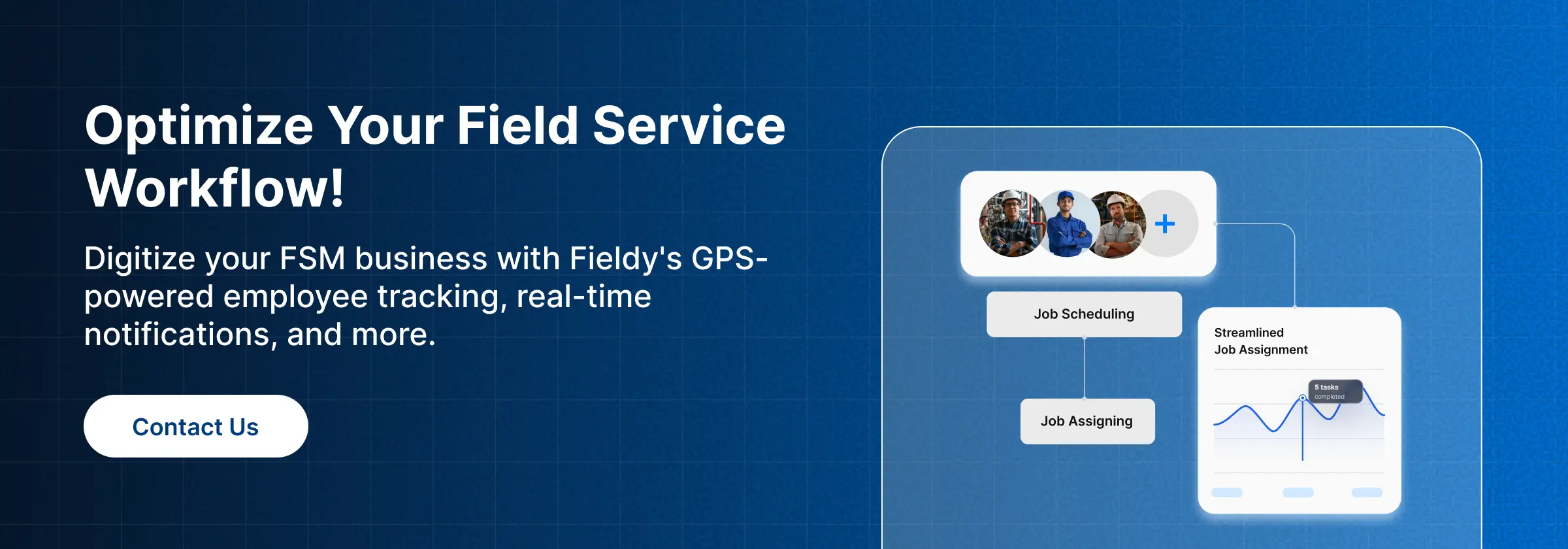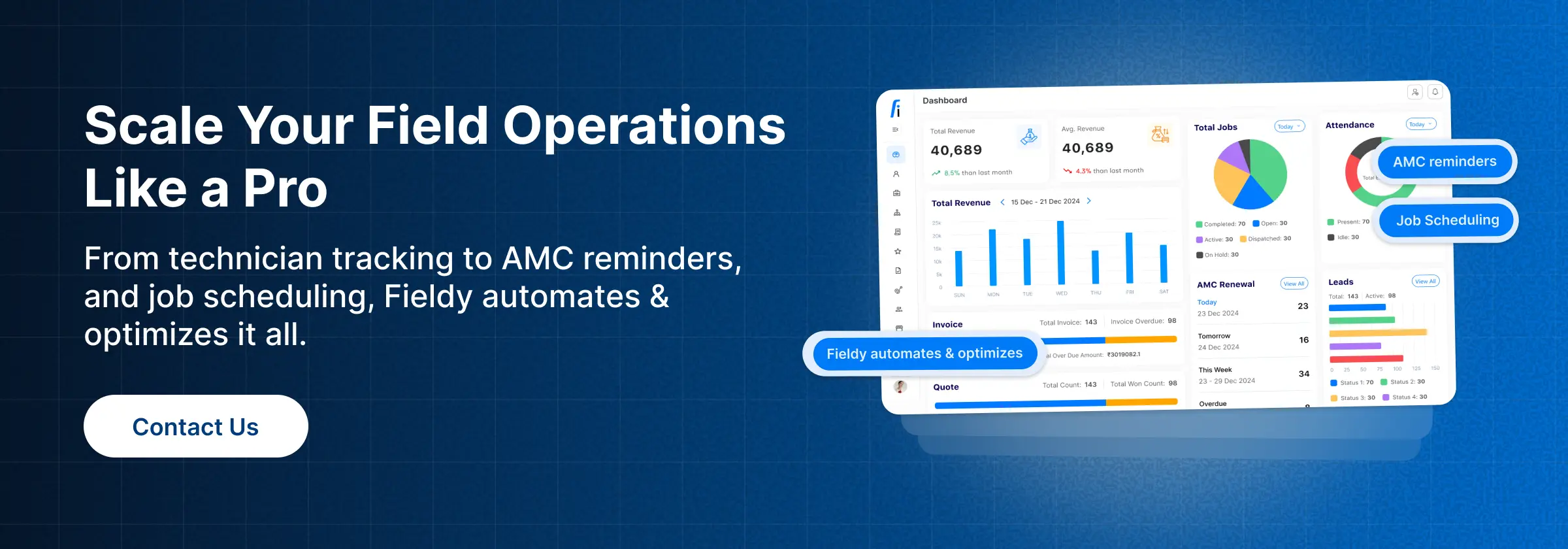Introduction
What Are Field Service KPIs?
Field service KPIs refer to measurable representations of performance and efficiency in field service operations. Those field service-based metrics represent a deep measure of how effectively service teams perform in real-world environments, including scheduling and dispatching to solution completion and customer interaction.
Why Should They Matter in 2025?
Customer expectations are on the rise, and digital transformation is accelerating, making it crucial to track the right field service KPIs and field service management metrics in 2025. A 2024 Aberdeen Group study reveals that organizations that track KPIs have 20% higher customer satisfaction levels and 15% higher technician productivity levels than those that do not.
When emphasizing the most relevant field service metrics, managers make data-driven decisions that maximize resource allocation, minimize operating costs, and continuously exceed customer expectations.
Best Field Service KPIs You Need to Keep Track Of
Being correctly tracked, field service KPIs will help improve service delivery, technician productivity, and customer satisfaction rates. There are several key field service KPIs that all service organizations should watch in 2025:
First Time Fix Rates (FTFR)
It tracks the percentage of service tickets resolved during the very first visit. A high first-time fix rate (FTFR) means fewer repeat visits, lower operational costs, and significantly higher customer satisfaction.
Example: An HVAC company increased its first-time fix rate through the integration of an HVAC field service management software and an accurate van stock list by 35%.
Why it matters: These days, customers demand quick and competent service. An inferior FTFR increases operational costs and reduces retention.
Technician Utilization Rates
This rate measures the percentage of working hours that are spent on billable tasks by a technician. High utilization means that the technician is rarely idle and is very productive.
Benchmark (2025): The top teams maintain utilization rates of 80-90 percent.
Mean Time to Repair (MTTR)
MTTR, being an average measure, determines the time involved in fixing service issues. It reflects the speed at which the team solves a problem and delivers a result, making this one of the major professional performance metrics in field service.
Tip: Implement a tool that permits real-time processing of employee job tracking, such as Fieldy, to update the technician’s progress and minimize any delays. These businesses have improved MTTR by 25% with automation and real-time insight.
Response Time
Time taken for the technician to reach the customer after a service request is said to be the response time. This is very important for industries such as plumbing or electricity, where a delay will only aggravate the situation.
Example: By geo-routing, plumbing companies brought the average response time down to under 90 minutes from 3 hours.
Job Completion Rate
It shows what percentage of the jobs assigned were completed satisfactorily within the set timeframe. The higher it is reflected, the better the reliability and accuracy of planning.
Tip: Integrating a field service scheduling software with mobile apps will allow real-time updates and prevent job delays.
These field service KPI examples allow service leaders to evaluate results from a broad perspective and engage in targeted interventions to improve outcomes.
Operational Metrics to Improve Field Service Management
Along with the performance-based KPIs, it would also be instrumental to track the field service management metrics to optimize the daily operations, reduce the cost, and enhance customer satisfaction. Here are some of those vital field service KPI metrics to watch out for:
Travel Time Per Job
Too much travel time decreases technician efficacy and limits the number of daily visits, but by implementing FSM software with smart routing capabilities, such as Fieldy’s employee GPS tracking app, you can minimize travel, improve technician efficiency, and reduce overall operational costs.
Insight: Companies using smart routing report 12–18% fuel savings and more jobs completed per day, a really important field service management metric to scale a company.
Parts Usage & Inventory Accuracy
Tracking parts usage ensures technicians have what they need while preventing stock-outs or overstocking. Using Fieldy’s real-time inventory management, you can monitor stock levels accurately and receive automated alerts when replenishment is needed.
Stat: 68 percent of service delays are caused by unavailable parts inventories. Inventory accuracy is a core KPI metric for field service, and it has a direct impact on first-time fix rates.
Schedule Adherence
This metric measures how well technicians adhere to scheduled appointment times; poor adherence disrupts workflow and damages customer trust, but using GPS tracking and automated reminders can help ensure consistent on-time performance.
Monitoring these field service management metrics will help improve planning, cut downtime, and provide consistently reliable service.
How to Measure and Track Field Service KPIs
KPI tracking provides continuous improvement in field service KPIs and is a must-have function. Manual ways tend to be error-ridden and time-consuming. The right tools should, thus, provide accuracy, efficiency, and Full real-time visibility.
Use of Field Service Software
Manual tracking yields inconsistent data and missed opportunities. With the modern-day field service management software like Fieldy, KPI tracking is thoroughly automated to provide timely insight.
Benefits:
- Accurate performance data
- Automatic job updates
- Integrated scheduling and reporting
- Real-time visibility into field service performance metrics
Using field service software solutions helps service managers act quickly, reduce inefficiencies, and boost overall performance.
Custom Dashboards and Reports
Custom dashboards provide metric-level insight regarding technician performance, job status, and operational health status in real time. Mobile reporting allows field staff to log updates instantaneously, thereby improving transparency and decision-making freedom.
Example: After field service teams began tracking jobs and KPIs in real-time through dashboards with automatic alerts, job delays dropped by 22% in telecoms.
These tools render the data actionable and available to all teams and thereby drive field service KPI improvement.
Field Service KPI Success with Real-World Examples
These field services statistics have had real, measurable impacts across industries:
HVAC: FTFR improved from 62% to 84% with diagnostic training and Fieldy’s real-time inventory. A saving of more than 300 technician hours; CSAT increased by 22%.
Plumbing: Fieldy’s AI routing of work orders reduced travel time by 20%, enabled payments for two extra jobs a day, on-time arrival increased from 76% to 91% and fuel consumption costs dropped by about 15%.
IT Services: Real-time monitoring lowered MTTR by 30% and increased SLA compliance from 68% to 92%, thus reducing penalties and improving retention.
Electrical: Dashboards and scheduling helped increase technician utilization by 18%, and billable hours by 25%.
The examples speak about how the right field service metrics lead to optimized operations and better results.
How To Choose the Right KPIs For Your Field Team
Not all KPIs are created equally. Choose KPIs that:
- Align with business objectives (e.g., customer satisfaction, profitability)
- Are SMART: Specific, Measurable, Achievable, Relevant, and Time-bound
- Reflect team roles, such as technician efficiency vs. dispatcher responsiveness
Tip: Start with 5–7 core KPIs, then scale as your tracking systems mature.
Common Mistakes to Avoid When Tracking KPIs
| Mistake | Description | Remedy |
|---|---|---|
| ✗ Too Many Metrics | Overloaded dashboards lead to analysis paralysis and lack of focus. | Prioritize key KPIs based on business goals and simplify dashboard views. |
| ✗ Ignoring Feedback | Technicians often know the real barriers to performance but aren’t consulted. | Encourage two-way feedback loops and involve field teams in KPI evaluation discussions. |
| ✗ Not Acting on Data | Metrics are collected but not used to drive meaningful improvements. | Use KPI insights to inform decisions, allocate resources, and implement process changes. |
| ✗ Lack of Visibility | Without mobile access, field teams can’t align with goals in real-time. | Choose an FSM tool with mobile-friendly, collaborative dashboards for full transparency. |
Best Practices to Improve Field Service KPIs
Improvement in field service KPI metrics always requires some element of strategy, training, and technology. Proven best practices for sustained field service KPI improvement include:
Set Realistic Benchmarks
Set achievable KPI targets using past performance data and industry standards. Benchmarking regularly enables teams to measure progress and drive continuous improvement.
Tip: Limit to 3-5 key field service KPI metrics so that efforts are focused and results can be measured clearly.
Technician Training on Tools and Processes
The better trained the technicians, the more the First-Time Fix Rate (FTFR) and Customer Satisfaction (CSAT) they will achieve. Concentrate on training your team for field service management tools, diagnostic apps, and communication skills.
Stat: Field teams that participated in monthly upskill sessions marked a 19% surge in job completion rates.
Automate as Much as Possible
FSM software lets you automate simple, time-consuming tasks, thereby allowing your workforce and managers to focus on more value-added tasks.
Automate:
- Scheduling and dispatch
- Inventory management
- Invoicing and job reporting
Automation enhances accuracy, reduces administrative burden, and accelerates overall field service KPI improvement.
2025 Field Service Metrics Trends
| Trend | Summary |
|---|---|
| ✓AI Insights | FSM uses AI for job assignment and predictive maintenance. |
| ✓Dashboards & Analytics | Real-time SLA alerts; shift optimization from historical data. |
| ✓IoT Devices | Devices alert the FSM systems directly. Eg: Utility firms cut unplanned downtime by 40%. |
Conclusion:
“Optimize KPIs with the Right Tools”
Tracking field service KPIs isn’t just about numbers—it’s about delivering faster service, reducing costs, increasing first-time fix rates, and keeping customers satisfied. In today’s competitive landscape, success depends on measurable performance.
With tools like Fieldy, field service companies can monitor, manage, and optimize field service metrics in real-time, making data-driven decisions that truly move the needle.
Want to see how you can improve your KPIs in real-time? Book a Free Demo with Fieldy today.


![A Comprehensive Guide on Field Service Metrics, KPIs, and Related Examples [Updated for 2025]](https://blog-admin.getfieldy.com/wp-content/uploads/2025/08/2025-Guide-on-Field-Service-Metrics-KPIs-and-Examples.webp)

